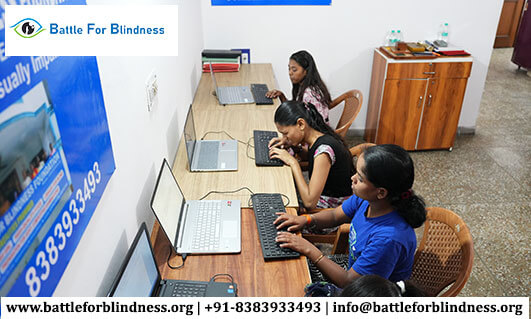
In recent years, advancements in Artificial Intelligence (AI) have been transforming various industries, but one area where AI has made an especially significant impact is accessibility for the visually impaired. Technology has the power to break down barriers and enhance the quality of life for people with visual disabilities. Through AI-driven innovations, visually impaired individuals are now able to experience greater independence, convenience, and connectivity in their daily lives. This blog explores how AI is reshaping accessibility for the visually impaired and empowering them to navigate the world with newfound confidence.
The Role of AI in Revolutionizing Accessibility for the Visually Impaired
AI has the potential to change the way the visually impaired interact with their environment. With the integration of AI in accessibility tools and devices, individuals who are blind or have low vision can perform tasks that were previously difficult or impossible. AI-powered solutions, such as smart assistants, image recognition apps, and navigation tools, provide real-time assistance, making everyday activities easier and more manageable.
1. AI-Powered Navigation Tools
One of the most groundbreaking developments for the visually impaired is the AI-driven navigation systems that guide individuals through unfamiliar spaces. These tools use AI algorithms to analyze surroundings and provide audio cues to help users navigate. For example, apps like Seeing AI and Aira enable users to interact with their environment, detect obstacles, and receive verbal descriptions of objects in their vicinity, making it easier for visually impaired individuals to move around with confidence.
These navigation tools offer features such as:
- Route planning: AI helps map out the safest and quickest routes, providing step-by-step instructions through audio.
- Obstacle detection: AI technology identifies and warns users about obstacles such as curbs, stairs, and people in their path.
- Real-time feedback: With AI, users receive real-time feedback to ensure they are heading in the right direction.
2. Smart Assistants and Voice-Controlled Devices
Voice-controlled assistants like Amazon Alexa, Google Assistant, and Siri have been a game-changer for accessibility. With simple voice commands, users can manage their daily tasks, such as setting reminders, controlling smart home devices, or accessing news updates. For the visually impaired, these voice-activated devices offer a seamless, hands-free experience that improves their independence and overall quality of life.
These devices utilize AI to:
- Read text aloud: AI-powered tools can convert text from books, documents, or websites into spoken words, making content accessible to visually impaired individuals.
- Offer personalized assistance: By understanding voice patterns and preferences, AI-driven assistants can personalize responses and tasks, providing a highly customized experience.
- Enable smart home controls: Through voice commands, users can control lighting, temperature, and even security systems in their homes, all without needing to see or physically interact with devices.
3. AI-Based Image Recognition for Visual Interpretation
AI technology has made significant strides in image recognition, which can assist visually impaired individuals in interpreting their surroundings. Apps like Be My Eyes and Seeing AI leverage computer vision to describe images and objects in real-time. Whether it’s reading text, identifying objects, or even recognizing people’s faces, AI provides a powerful tool that gives users a more detailed and informed perspective of their environment.
Key features of AI-based image recognition include:
- Object recognition: AI can identify objects, such as products in a store or items on a desk, and describe them to users.
- Text reading: Optical character recognition (OCR) technology enables AI to read printed or handwritten text aloud, helping users access books, labels, and signs.
- Scene description: AI can describe an entire scene, from the layout of a room to the actions taking place in the vicinity, helping the visually impaired stay informed and aware.
4. AI in Education and Employment for the Visually Impaired
AI is not only changing how the visually impaired navigate their environments, but it is also transforming educational and employment opportunities. Through AI-enhanced learning tools, students with visual disabilities can access educational content in formats that suit their needs. Tools like Kurzweil 3000 and Read&Write provide text-to-speech and other AI-driven accommodations that enable visually impaired students to learn more effectively.
For employment, AI-powered tools provide valuable assistance in tasks that may otherwise be challenging. In workplaces, AI technology helps with document reading, scheduling, and even attending virtual meetings through voice assistants, enabling visually impaired professionals to perform their roles independently and efficiently.
5. AI and Healthcare for the Visually Impaired
AI is making a difference in the healthcare sector, specifically for visually impaired individuals. From AI-based diagnostic tools to wearable devices, technology is revolutionizing healthcare access and improving overall well-being. For example, smart glasses equipped with AI can detect health-related issues and provide feedback to the user or healthcare providers.
Moreover, AI-driven applications help visually impaired individuals monitor their health, track physical activities, and even detect early signs of visual impairments. These applications also serve as reminders for medication schedules or doctor’s appointments, helping users manage their healthcare with ease.
Conclusion: A Vision of the Future
The integration of AI into the lives of the visually impaired has led to remarkable advancements in accessibility. From AI-powered navigation tools to voice-controlled devices and image recognition apps, technology is playing an essential role in empowering visually impaired individuals. As AI continues to evolve, it holds the potential to unlock even more opportunities for inclusivity, independence, and empowerment.
At its core, AI is about removing obstacles and creating a more accessible world for people with visual impairments. With continued innovation and collaboration, the future promises even greater possibilities for enhancing the lives of the visually impaired, making the world a more inclusive place for all.





